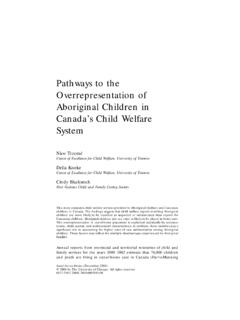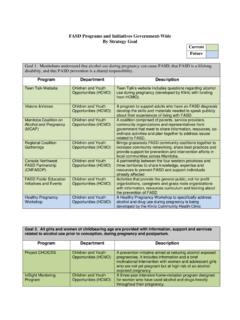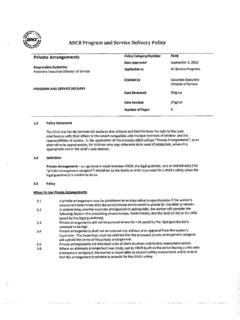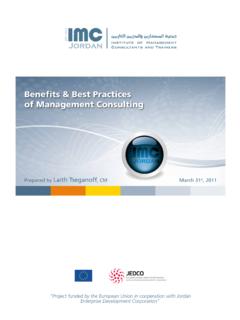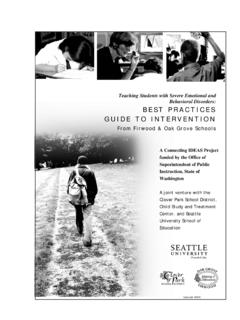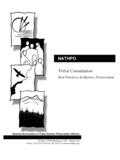Transcription of A REVIEW OF BEST PRACTICES IN CHILD WELFARE
1 1 A REVIEW OF best PRACTICES IN CHILD WELFARE by Alexandra Wright, PhD Introduction The Canadian CHILD WELFARE system is complex, based in federal, provincial, and territorial legislation and policies, encompassing a range of services to Canada s diverse population. The CHILD WELFARE system faces many challenges such as supporting and preserving families while ensuring the right of a CHILD for protection from harm, and respecting the rights of parents to have minimal state intervention (Bala, 2011).The current system is generally considered to reflect an institutional approach to CHILD WELFARE in that the family is viewed as a private entity that requires and receives social services when faced with hardships to ensure functioning (Armitage, 1993, p.)
2 42). Mandated CHILD WELFARE services are provided through government offices, private, not-for profit agencies, and health centres, and CHILD WELFARE services can range from prevention to protection (such as community empowerment and family support initiatives, abuse investigations, legal, alternate care), involve multiple service providers (family services workers, counsellors/therapists, nurses), and across numerous fields (social work, education, mental health, addictions, criminal justice, medical). The Canadian Incidence Study of Reported CHILD Abuse and Neglect (CIS) (a national surveillance program of the Public Health Agency of Canada) reported an estimated 235,842 CHILD maltreatment investigations in 2008 in Canada with over 60,000 cases requiring ongoing services (Public Health Agency of Canada, 2010, p.
3 25). Of the initial cases, 36% were substantiated, reflecting a CHILD maltreatment rate of 14 per 1000 children. The CIS reported that 22% of substantiated cases involved Aboriginal children. In Manitoba, in 2010-2011, the Department of Family Services and Consumer Affairs reported that there were 19,000 children and families receiving CHILD WELFARE services (Government of Manitoba, 2011). The social, cognitive, emotional, psychological, and behavioural costs of CHILD maltreatment are high (Goldman, Salus, Wolcott, & Kennedy, 2003). In Canada annual costs have been conservatively estimated to reach 16 billion dollars (based on a calculation of judicial, social services, education, health, employment and personal costs in 1998) (Bowlus, McKenna, Day, & Wright, 2003).
4 2 CHILD WELFARE policies and services often reflect diverging political, legal, economic, and cultural perspectives and understanding, and explanations of the causes of CHILD maltreatment and corresponding solutions reflect those differences. In this challenging policy and practice context, services are expected to meet legislated requirements in a professional manner, ensuring that minimal standards of service are met. best PRACTICES (BP) are a relevant and important topic in the CHILD WELFARE field as BP provide the identification of standards for service planning and delivery and provide guidance to improve policies and services for children and their families. Ultimately the benefits of BP should ensure the safety, health, and well-being of children, families, and communities.
5 This document provides an overview of BP in CHILD WELFARE and builds on a prior literature REVIEW written for the Office of the Children s Advocate and the Ombudsman in 2006. Given the publication of significant contributions to the field, the paper has been updated and greatly revised. Certain sections are expanded ( community approaches to CHILD WELFARE ) whereas others have been reduced ( direct practice with families). The paper is structured to present BP on a system level, community level, organizational level and direct service (practice) level, reflecting an ecological and critical perspective of CHILD WELFARE that emphasizes the context of children within their families, their community, and the broader social system, as well as in the relationship with CHILD WELFARE agencies and other service organizations.
6 The paper highlights PRACTICES based on research findings and conceptual contributions considered to support effective CHILD WELFARE services. Given the extent of writing on the topic of CHILD WELFARE , the paper provides an overview of principal elements important to consider within this topic. The paper does not provide a complete REVIEW of all research papers or conceptual writing on CHILD WELFARE , and in certain sections, the paper directs the reader to useful resources (such as seminal texts or practice guides). Kufeldt s and McKenzie s CHILD WELFARE , Connecting Research, Policy, and Practice (2011) provides an excellent example of a recent contribution addressing CHILD WELFARE issues that should be required reading for any CHILD WELFARE policy maker or service provider.
7 The joint publications from the Prairie CHILD WELFARE Consortium and the Centre of Excellence CHILD WELFARE (2007, 2009, & 2012) also provide examples of research findings, conceptual frameworks, practice approaches, and policy analysis based on the Prairie CHILD WELFARE context. Consequently this REVIEW does not purport to be an exhaustive summary of all BP in CHILD WELFARE planning and service delivery, rather it intends to provide the reader with a 3 basic REVIEW of key issues and contributions to this topic area, and a framework within which to order the information. The paper begins with a definition of BP and an explanation of an ecological and a critical structural perspective. The paper then proceeds to present relevant CHILD WELFARE issues in the following sections: system, community, organizational, and direct practice level.
8 Each section concludes with key points and recommendations. Throughout the paper, the term CHILD WELFARE workers and service providers are frequently interchanged with social workers, as graduates with a social work degree frequently provide CHILD WELFARE services. best PRACTICES in CHILD WELFARE A basic tenet of this paper is that BP should be incorporated as a systemic approach to CHILD WELFARE planning, provision, and evaluation. best PRACTICES can be defined as the measurement, benchmarking, and identification of processes that result in better outcomes (Kramer & Glazer, 2001, p. 157). A variety of terms, based on the use of evidence to inform decision-making can be used to describe best PRACTICES in CHILD WELFARE . For example the terms standards , quality , and evidence-based (EB) practice are frequently used to describe BP and are approaches used to achieve BP in CHILD WELFARE (Corcoran & Vandiver, 2006; Holden et al.)
9 , 2012). The use of evidence in social work practice provides social workers with the means to manage uncertainty in complex and challenging work environments (Holden et al., 2012). Evidence-based (EB) social work has its origins in the 1970s with advocates arguing that the interventions provided should be based on the best available evidence (for a thorough REVIEW of EB practice please refer to Roberts & Yeager, 2006 and McAuley, Pecora, & Rose, 2006). EB practice is a way of doing practice which involves an individualized, thoughtful process of using evidence to make collaborative decisions with actual or potential services users (Mullen & Streiner, 2006, p. 24). EB PRACTICES are based on three elements: best research evidence best clinical experience Consistent with family/client values (American Public Human Services Association (APHSA), 2005) Gilgun (2005) adds a fourth element, the practitioner or worker s personal assumptions, values, biases, and world views and the importance of self-reflection (p.
10 52). Generally 4 however, EP practice requires the consideration of the three elements whenever possible, in decision making (Thyer & Myers, 2012). EB practice also encompasses broader organizational issues such as governance, administration, management and policy (Mullen & Streiner, 2006) and is based on the premise that all aspects of the service delivery system should be organized and provided based on research that provides evidence of effectiveness (Wilson, 2006). Similarly, the term outcomes-based practice is a means to identify effectiveness of interventions based on research/evaluation (Trocm , 2003). The focus of outcomes-based research is outcomes, as opposed to processes, and outcomes are identified via indicators or measures considered to reflect successful dimensions of CHILD and family services (Kufeldt & Th riault, 1995).
